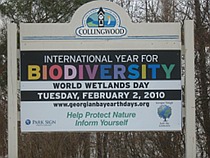The Montreal biodiversity agreement offers us a better chance for survival.
“Nature is our ship. We must ensure it stays afloat”
Virginijus Sinkevičius, EU Commissioner for the Environment, Oceans and Fisheries
“Forget the dreams of some billionaires. There is no planet B.”
António Guterres
“This global agreement is a win for people and the planet. We are pleased that it recognizes the need to protect much more land and ocean, and equally that Indigenous leadership and quality of protection is key to success.”
Sandra Schwartz, National Executive Director, Canadian Parks and Wilderness Society
The UN biodiversity summit in Montreal (COP15) has now come to a close. Governments, corporations and individuals must see the resulting Kunming-Montreal Global Biodiversity Framework (GBF) for 2030 as a floor and not a ceiling for humanity’s resolve to stop biodiversity loss and then accelerate immediately the commitments to include strong levels of implementation. So, for example, Target 3 of the GBF requires that 30% of both land and oceans be protected by 2030, but as the great biologist E.O. Wilson pointed out, the planet can only truly rebound and be a safe haven for Nature if we vigorously protect 50% of Earth, while emphasizing that Indigenous knowledge and inclusion in biodiversity agreements be sacrosanct.
Because of the very real possibility that the entire biodiversity framework would have failed without it, I thought it vital to include the full text of Target 3 here: “Ensure and enable that by 2030 at least 30 per cent of terrestrial, inland water, and coastal and marine areas, especially areas of particular importance for biodiversity and ecosystem functions and services, are effectively conserved and managed through ecologically representative, well-connected and equitably governed systems of protected areas and other effective area-based conservation measures, recognizing Indigenous and traditional territories, where applicable, and integrated into wider landscapes, seascapes and the ocean, while ensuring that any sustainable use, where appropriate in such areas, is fully consistent with conservation outcomes, recognizing and respecting the rights of Indigenous peoples and local communities including over their traditional territories.”
Equally important is Target 22: “Ensure the full, equitable, inclusive, effective and gender-responsive representation and participation in decision-making, and access to justice and information related to biodiversity by Indigenous peoples and local communities, respecting their cultures and their rights over lands, territories, resources, and traditional knowledge, as well as by women and girls, children and youth, and persons with disabilities, and ensure the full protection of environmental human defenders.” After the murder of thousands of Nature defenders the inclusion in this target has great significance.
Many of the targets are cause for celebration. Please take the time to read the document linked at the end of this article, as only an informed society can move us to an ecologically based civilization.
Although the Montreal–Kunming agreement is not legally binding, governments will be tasked with showing their progress towards meeting the targets through national biodiversity plans, akin to the nationally determined contributions countries use to show progress on meeting the goals of the Paris climate agreement. You may be entirely justified in being sceptical as to whether any progress in combating biodiversity will be made if the climate contributions example is anything to go by. Nevertheless, after years of wrangling, the four goals and 23 targets in the GBF are without a doubt a major step forward. The aims of the COP15 biodiversity summit contrast significantly with those of the COP27 climate summit that took place in Egypt last month.
However, despite the perceived success of COP15, scientists, youth and Indigenous Peoples have huge and ongoing concerns about whether the GBF process will emerge into a successful outcome for a resilient and flourishing planet. Here is an important appraisal of where we stand. Please see also the Guardian’s analysis of the conference.
I attended COP15 in Montreal. It displayed both the best of humanity, whereby scientists, Indigenous biodiversity campaigners and groups including young people passionately and articulately made their cases known, and – albeit to a far lesser extent than at the UN climate summits – the entrenched mindset of a political/corporate order that is hell-bent on protecting a rapidly failing capitalist unliveable agenda.
Just as we saw at the climate conference in Egypt this November that the global north resisted giving money to the global south in the form of restitution and compensation under Loss and Damage to help poor countries protect themselves from the ravages of climate breakdown brought on by the industrial north, but will hand out trillions of dollars in subsidies for fossil fuel ventures, so too will abundantly biodiverse countries such as are found in Amazonia and Africa find few doors opening to enable them to receive the generous sums they require to protect the world’s most resplendent biodiversity. Finance for the Global Biodiversity Framework is a critical component for successfully going forward towards 2030 and beyond. As a financial consultant for The Nature Conservancy said in a media forum, it isn’t a matter of how many water glasses there are on the table, but of how large the water pitcher is to distribute equitably and fully what is truly needed. If you wish to see the amounts of money pledged by governments, philanthropists and corporations, see www.naturefinance.info
The protest march that I attended for biodiversity and human rights on December 10, UN Human Rights Day, brought out maybe 3,000 people, who made their voices heard close to the Palais des Congrès, where COP15 was taking place. In a city that has almost 2 million inhabitants, it’s fair to ask why there weren’t more people marching. We know that a healthy biosphere and vibrant human rights are intertwined, but why has the conference been kept such a secret?
It’s not only mainstream media and governments that prioritize everything except the protection of life on this planet. Corporations’ self-inflicted ignorance appears to know no bounds when their unchecked lack of actions to put their businesses in sync with ecological realities is revealed. “A nature-positive future demands that companies look beyond climate goals. Companies can and must take direct action to halt biodiversity loss. Companies’ transparency on biodiversity hotspots and endangered species is low,” the revealing website of the World Benchmarking Alliance tells us. Only 5% of major companies assessed know how their activities impact Nature, and only 1% know to what extent their activities depend on Nature. This is utterly tragic for all life on the planet.
Most global companies display shocking indifference towards the natural world in their pursuit of profit. By default ecocide is written into their very business models. The COP15 agreement puts corporations on notice: take on board a responsible action plan for biodiversity, or your bottom line will be severely impacted.
On top of this, the whole education system is at fault, with the universities at the helm of this debacle. My attempts to have Bishop’s University acknowledge COP15 and most importantly give students the opportunity to acquaint themselves with and respond to possibly the greatest existential crisis that will determine their own success in life failed to gain traction.
“I have planted a false oath in the earth, it has brought forth a poison tree
from Vala, or the Four Zoas by William Blake
I have chosen the serpent for a councellor & the dog
For a schoolmaster to my children
I have blotted out from light & living the dove & nightingale
And I have caused the earth worm to beg from door to door
I have taught the thief a secret path into the house of the just
I have taught pale artifice to spread his nets upon the morning
My heavens are brass my earth is iron my moon a clod of clay
My sun a pestilence burning at noon & a vapour of death in night”
Since 80% of Earth’s intact biodiversity is to be found where Indigenous peoples live, and since Indigenous peoples are now recognized as the best stewards of Nature, any COP15 Global Biodiversity Framework that guides us to 2030 and then towards a vision of living in harmony with Nature and a global ecological civilization must require that human rights be embedded into that framework. And they are! Past and present colonialism has refused to protect and recognize Indigenous lands. On a national level an agreement at COP15 must change that. In Canada it can begin with cancelling the Trans Mountain Pipeline and closing down the failing Line 5 pipeline that is now a real risk to the Great Lakes and the Aboriginal First Nation tribes that have been and continue to be sustained by their ecological harvesting of wild rice in that region, let alone to the 40 million people who rely on clean drinking water. Please see www.forestpeoples.org to better understand the fundamental connection between human rights and a just biodiversity policy negotiated at COP15.
The Global Youth Biodiversity Network maintained that there must be a principle on intergenerational equity written into the goals and targets of the GBF. Together with children’s and women’s participation, this is now part of Target 22’s goals for protecting human rights.
Please listen to the December 18 assessment by the World Wildlife Fund to better understand what pitfalls existed both before the final negotiations on December 19 and after the final GBF text was agreed. It is revealing. You will also be able to see the overwhelming goodwill exhibited at the summit. An ongoing open working group will try to raise ambitions. The questions on everyone’s minds have been, has enough been included to secure an ambitious global biodiversity agreement? And if not, where do we go from here?’ These COP goals and targets must be enshrined in legislation. We must all strive to bring this about. Future generations of all life forms depend on us. Let’s make it happen; implement the necessary legal framework. Undoubtedly it is our universal responsibility.
Please see the final release of the COP15 agreement.


